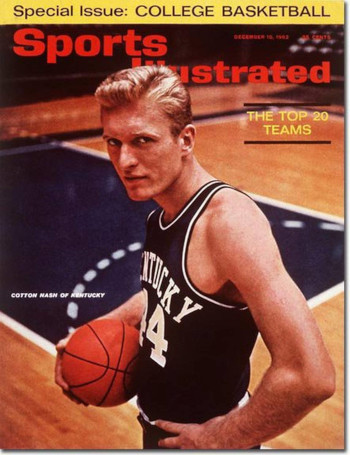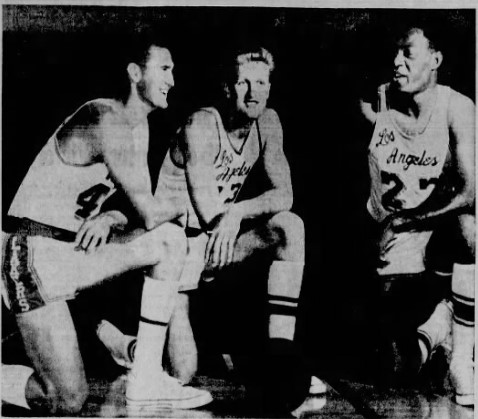The NCAA Division I Basketball Championship is over. So, this will be my final entry about Evansville baseball and prominent college basketball players.
Charles Francis “Cotton” Nash was a Kentucky basketball legend along the lines of Corky Withrow, but unlike Corky he plied his college hoops trade at the summit. Like former Evansville Brave Ralph Beard, he was a University of Kentucky Wildcat. A lanky forward standing halfway between six and seven feet tall, Nash led Adolph Rupp’s early 1960s teams to number one in the national polls. Nash had an Indiana connection before his professional baseball career, which ultimately led him to Kentucky. He discovered basketball in the Hoosier state after his family moved here when he was 11. He played basketball under head coach Cliff Barker, a former U.K. player and star, at Jeffersonville High School. After his sophomore year, his father was transferred to Texas, near the Louisiana border.
The Nash’s took up residence in Louisiana, so Cotton wouldn’t have to sit out a year of high school sports, which Texas would have required. Nash played nearly every sport and excelled in all. He came to the Bluegrass State after a storied sports career at a high school (Lake Charles) without a baseball team, the sport he most wanted to play. Cotton Nash set the college basketball afire while at U.K. He appeared on the cover of Sports Illustrated in December 1962.

Nash was the highest scorer in the history of the Wildcat basketball program and led the Southeastern Conference in scoring his senior year. As a unanimous All-American, he was picked in the second round of the NBA draft by the Los Angeles Lakers. Nash also pitched and played outfield for the University of Kentucky, performing so well he was considered a baseball prospect in the $60,000 bonus range. Twelve days after the 1964 NBA draft Nash signed to play baseball in the Los Angeles Angels organization for a much lesser bonus, but the Angels removed a standard clause about competing in another sport. The Lakers, likewise, had no objections, and signed him to a multi-year contract. He tried both sports.
The Angels sent the lanky first baseman to its Triple-A Hawaii affiliate where he played two games before being shipped to Class-A San Jose. There he got his minor league sea legs. His NBA career sputtered after one season. Nash was released by the Lakers after playing in 25 games behind Elgin Baylor. He played 20 more NBA games with the San Francisco Warriors, who ad picked him up on waivers in February 1965. When the basketball season ended, Nash made the decision to concentrate solely on his favorite sport, baseball.

Nash joined the Chicago White Sox organization in 1967 in a trade that sent Moose Skowron to the Angels. The Chisox sent him to Evansville of the Class-AA Southern League. After a quick start (.310 BA in 17 games), Nash was called up to Triple-A Indianapolis. Nash hit only one home run in cavernous Bosse Field during that stay. At Indianapolis he banged out 28 dingers and earned a September call-up to a Chicago team in the middle of the wild 1967 American League pennant race. Learning Nash was once a boxer Sox manager Eddie Stanky told a United Press International reporter he summoned Nash to serve as his bodyguard. “His number one job is to protect the manager,” quipped Stanky. “We’ve got him because we expect trouble.” Stanky got more out of Nash than physical protection. One inning during the height of pennant race etched Nash’s name in Chicago baseball history.
Nash’s famous inning came in the first game of a September 10 doubleheader against Detroit at old Comiskey Park in front of 23,625 fans. Detroit, Chicago, Minnesota and Boston were in a four-way battle for the American League pennant. Entering the bottom of the ninth, manager Eddie Stanky sent Nash in as a defensive replacement for Ken Boyer at first base. This wasn’t an ordinary late game defensive move. It was more. Chicago pitcher Joel Horlen was leading 6-0, and more importantly the Tigers were hitless through the first eight innings.
The first batter in the ninth, Jerry Lumpe, hit a ball up the middle that Sox second-baseman Wayne Causey made a backhanded pickup. Causey turned and threw off balance to first base. The 6-foot-6 Nash stretched for the throw. In a bang-bang play first-base umpire John Steven emphatically called Lumpe out. Tiger manager Mayo Smith rushed from the dugout to argue to no avail. Many still believe that Cotton’s extra few inches of stretch made the difference (Boyer was 6-foot-one). Horlen retired the next two batters on easy ground balls. Nash recorded all three putouts at first as Horlen recorded the 12th no-hitter in White Sox history. It would be another 40 years before the franchise recorded another.

Pictures of Nash, wearing number 50, and Sox teammates appeared in newspapers across the nation after Horlen’s gem. Photographers captured jubilant White Sox players mobbing the pitcher. It was a successful year all around for Nash. Earlier in June a new pro basketball league formed as the American Basketball Association. He signed with the Kentucky Colonels. “They kept calling me and calling me,” he said later, “They offered terms I couldn’t turn down.”
The ABA’s first season started as the baseball season ended in October. Nash was in the starting lineup for Kentucky in the early part of the inaugural season, but when Colonels coach John Givens was fired near mid-season, his replacement, Gene Rhodes, relegated Cotton to bench duty. Halfway through the season Nash was asking himself “what have I done?” He wanted to ready to play baseball in the spring. After only 39 games Nash quit basketball for good in January 1968. “I decided that two sports were too much, that my baseball chances would be better if I gave up basketball,” he told the Chicago Tribune.

Nash’s journey brought him back to Evansville for the summer of 1968 after batting .179 at the Chisox Class-AAA team in Hawaii. He knocked out six home runs in 75 games with the Esox. After another season at Minnesota’s Triple-A affiliate in Denver, Cotton was called up for a late season stint with the Twins where he had two hits in nine at bats at the end of 1969. The Twins moved their Triple-A team to Evansville in 1970. Nash returned and blasted 33 home runs, the second most home runs in Evansville minor league history behind Frank Roth’s 36 in 1901. Another late year callup to Minnesota gave him his last shot in the bigs. He batted four times and singled once. The end of his major league career left him as a .188 hitter in 16 trips to the plate.

Although Nash blasted 37 home runs for Portland in 1971, he ended his baseball career after the 1972 season. He passed away in November, 2023 at the age of 80.

Leave a Reply